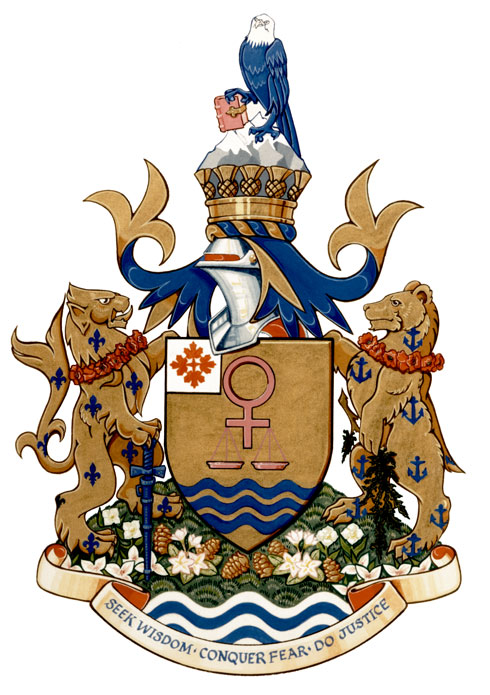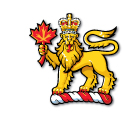- The Governor General of Canada

The contents of this Register are intended for research purposes only. The heraldic emblems found in the Register may not be reproduced in any form or in any media without the written consent of the Canadian Heraldic Authority and/or the recipient.
Avril Kim Campbell
Vancouver, British Columbia
Grant of Arms and Supporters
January 25, 1995
Vol. II, p. 380

[ previous page ]
Blazon
Arms
Or the universal symbol for a woman pendant from its crosspiece a pair of scales Rose and in base three bars wavy Azure on a canton the mark of the Prime Ministership of Canada (Argent four maple leaves conjoined in cross at the stem Gules);
Crest
Issuant from a coronet the rim set with thistle heads Or on snowy mountain peaks Proper an eagle Azure head Argent its dexter leg resting on a closed book Rose clasped Or;
Supporters
On a grassy mound set with dogwood flowers, trillium flowers and Mayflowers Proper and pine cones Or rising above barry wavy Argent and Azure dexter a lion Or semé of fleurs-de-lys Azure gorged with a collar of poppy flowers Gules its dexter foreclaw resting on the pommel of a sheathed sword point downwards Azure embellished Or sinister a female bear Or semé of anchors Azure gorged with a like collar its dexter forepaw grasping a branch of cedar Vert embellished Or;
Motto
SEEK WISDOM · CONQUER FEAR · DO JUSTICE;
Symbolism
Arms
The scales of justice refer to Ms. Campbell’s legal profession and to her service as Minister of Justice. They are shown with the universal symbol for a woman, indicating that she was the first woman to be Prime Minister of Canada. Pink is a reference to the distinctive colour used in her 1993 campaign for the leadership of the Progressive Conservative party. The three wavy blue bars, also found in the arms of Ms. Campbell’s home province of British Columbia, refer to both the Pacific Ocean and to three major elements of her career: the law, teaching and politics. The heraldic emblem of the Prime Minister of Canada appears in the upper left.
Crest
The coronet of thistles recalls Ms. Campbell’s Scots heritage. The bald eagle is a fearless and majestic bird widely seen in British Columbia, and it is an emblem of wisdom for many of the First Peoples. The book refers to her ongoing involvement with various types of study and teaching.
Supporters
The lion refers to Ms. Campbell’s father, with the poppies recalling his war service and the fleurs-de-lis his Montreal birthplace. The sword also refers to his military service and to the fact that Ms. Campbell served as Minister of National Defence. It is sheathed to refer to preparedness and defence of peace. The bear symbolizes British Columbia as well as Ms. Campbell’s Soviet studies, the bear being a symbol of Russia. The anchors refer to her mother's service in the Royal Canadian Navy. The cedar branch is a First Nations symbol honouring the nurturing and caring characteristics of women. The grass and water represent the land, rivers, lakes and oceans of Canada. Ms. Campbell’s ancestral heritage is symbolized by the provincial flowers of Nova Scotia, Ontario and British Columbia, as well as by the pine cones, a reference to the 17th century pine tree emblem of Massachusetts.
Motto
Not applicable
